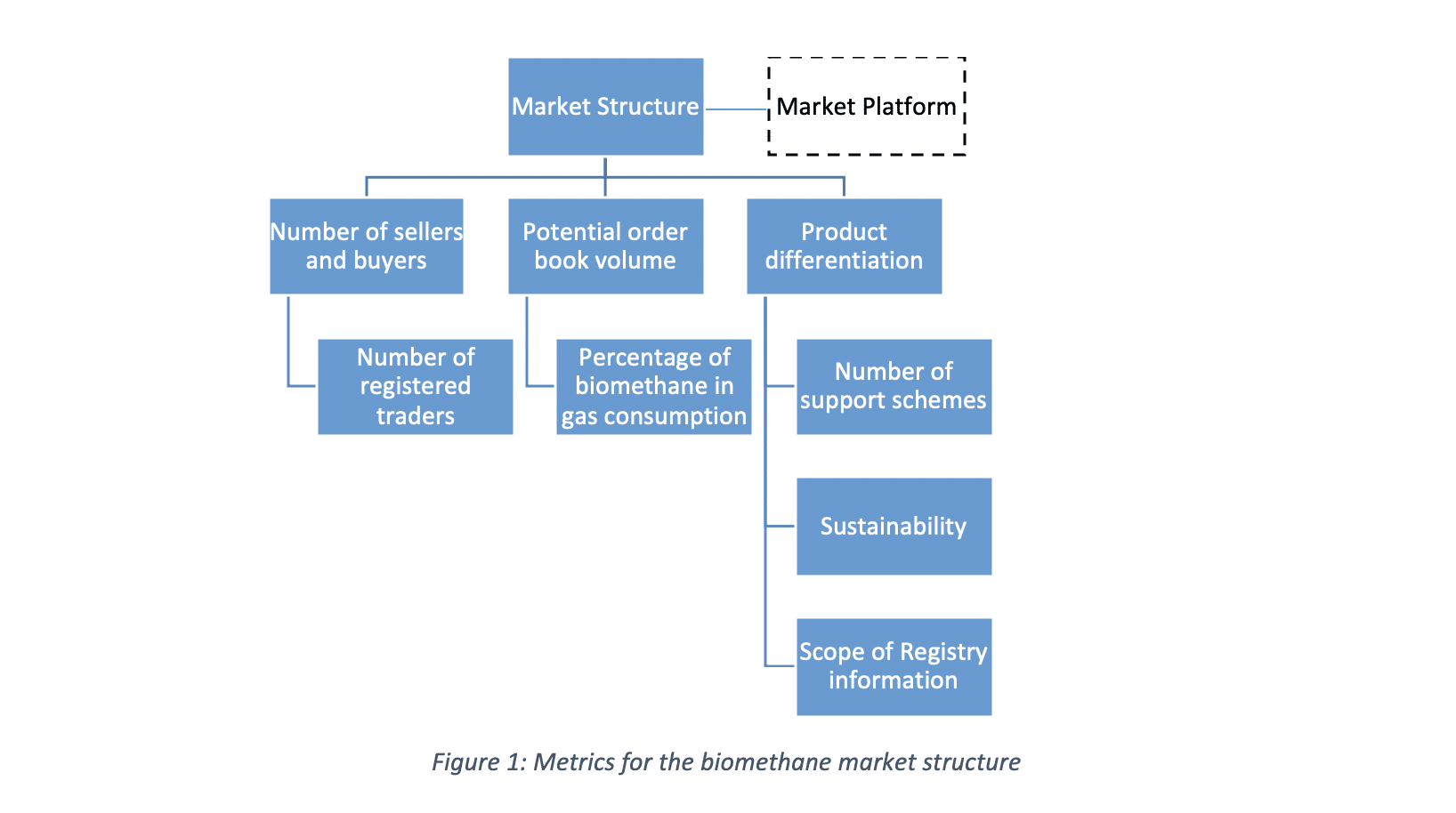The Biomethane Target Model
This is the third installment of the Topic of the Month: A European Journey to renewable gas markets
The Biomethane Target Model: Market structure, competition, and product differentiation
The existence of markets incentivises price decreases from producers, while increasing demand, not only due to lower prices but also due to a better product in the sense of e.g. reliability and branding. Most of the economic theory on markets, focuses on existing markets with well-defined products. For biomethane, this is not given. Biomethane and other renewable gases in European countries are primarily traded through bilateral agreements, thus we cannot have a clear insight on the trading activities, which makes the current market rather non-transparent.
The focus of the Biomethane Target Model is the market structure, and the degree of competition within the market. A high degree of competition, meaning a high number of sellers and buyers, can result in an efficient use of resources and limits the firm's market power.
Leaning on the economic theory, and the Agency for the Cooperation of Energy Regulators’ (ACER) gas target model [1], we aim to organise and find a structure for biomethane trade in the EU. For this purpose, we use the methodology used for the development of natural gas market hubs as a starting point, since natural gas as an energy carrier, is the most similar to biomethane. However, biomethane and renewable gases have a sustainability dimension that is not prevalent for natural gas. Additionally, the natural gas market is by far more mature than the biomethane market. Therefore we need to adjust the approach accordingly.
We define a set of metrics in order to measure the readiness of biomethane trading activities to be facilitated in a separate trading platform (see figure 1). In the past, ACER [2] has used an approach in its European gas Target Model where two sets of metrics that quantify and measure the “market health” and “market participant’s needs fulfillment” of European gas trading hubs are defined. The analysis conducted by ACER shows that even with the well-developed gas market with its liquid trading hubs, most EU Member States are showing deficits regarding these metrics. This situation will look even worse for biomethane, without a trading hub, and with almost no insight on prices and trading activities.
Since we have no insight over the number of contractual suppliers in the biomethane market and the number of end-users who specifically buy biomethane, we can only refer to the number of registered traders. This number can be misleading since not all registered traders are active traders, but it is the closest number accessible for evaluating the number of buyers and sellers in this market.

The ACER gas target model has included the order-book volume in its metrics for evaluating natural gas hubs. We use that metric, with modifying it to be the “potential” order book volume, which consists of the available volumes of biomethane available in the market. This can be reflected in the percentage of the gas consumption in the respective country, which is covered by biomethane.
1. Product differentiation
We have defined three measurable metrics for differentiating biomethane in the context of this study: the scope of the biomethane registry, sustainability standards, and the number of differentiated products.
1.1 Scope of biomethane registry
A biomethane registry is a documentation system serving the seller or buyer of biomethane to track and handle it as biomethane with a certain set of characteristics. This increases trust and improves the documentation along the biomethane supply chain [3].
National registry operators can further adjust and develop their registries to make them compliant with the EU RED mass balance system. This adjustment will be less cost and administration intensive, if the scope of the registry already entails all the parts of the biomethane supply chain, from feedstock production to end-consumption. Therefore, we use the scope of the biomethane registry as a metric for how close a chain of custody is to an EU RED compliant mass balance system. We use the whole biomethane supply chain as a benchmark, and observe the steps of the value chain that are included in the biomethane registry of the respective country.
1.2 Sustainability standards
Sustainability in the EU RED context has two angles: GHG mitigation, and the origin of the feedstock used for biomethane production (land use) [4]. The methodology to calculate GHG mitigation is described in Annex V of the EU RED II. For “biofuels, bioliquids and biomass fuels produced from waste and residues, other than agricultural, aquaculture, fisheries and forestry residues” (Article 29 EU RED II) fulfilling the GHG mitigation criteria is sufficient to contribute towards renewable energy goals [5]. These criteria have harmonised the sustainability for biomethane used for transport to a certain extend. Some countries have implemented other sustainability criteria for biomethane used in other sectors. Moreover, EU Member States set different rules regarding the maximum percentage of energy crops used for biogas and biomethane production. As an indicator for the sustainability of the biomethane produced in a country, we use this share as the metric we will analyse. We simplify the sustainability requirements for biomethane such, that a lower mass-percentage of energy crops allowed in a country leads to a more sustainable its biomethane.
1.3 Number of support schemes
Support schemes are currently what ensure the income of biomethane producers. Currently, they determine the value of biomethane in different countries. Each support scheme represents a niche market for biomethane. Therefore, we take the number of support schemes for biomethane in a country as a metric for evaluating the degree of differentiation of biomethane. Each monetary benefit given to the application of biomethane counts as a differentiated product, hence, a niche market.
References
[1] ACER, European Gas Target Model – review and update Annex 6 Tools for gas market integration and connection, (2015).
[2] ACER, European Gas Target Model Review and Update, (2015) 43.
[3] Becker Buettner Held, „ Entwicklung und Umsetzung eines Leitfadens zur EEG – konformen Dokumentation von Biomethan “, 49 (2018).
[4] European Commission, (RED) DIRECTIVE (EU) 2018/2001 OF THE EUROPEAN PARLIAMENT AND OF THE COUNCIL of 11 December 2018 on the promotion of the use of energy from renewable sources (recast), (2018).
[5] Council of the European Union, Proposal for a Directive of the European Parliament and of the Council on the promotion of the use of energy from renewable sources – Analysis of the final compromise text with a view to agreement, 2018 (2018) 1–269. https://doi.org/10.1016/j.wasman.2011.07.026.
Read the previous installment:







